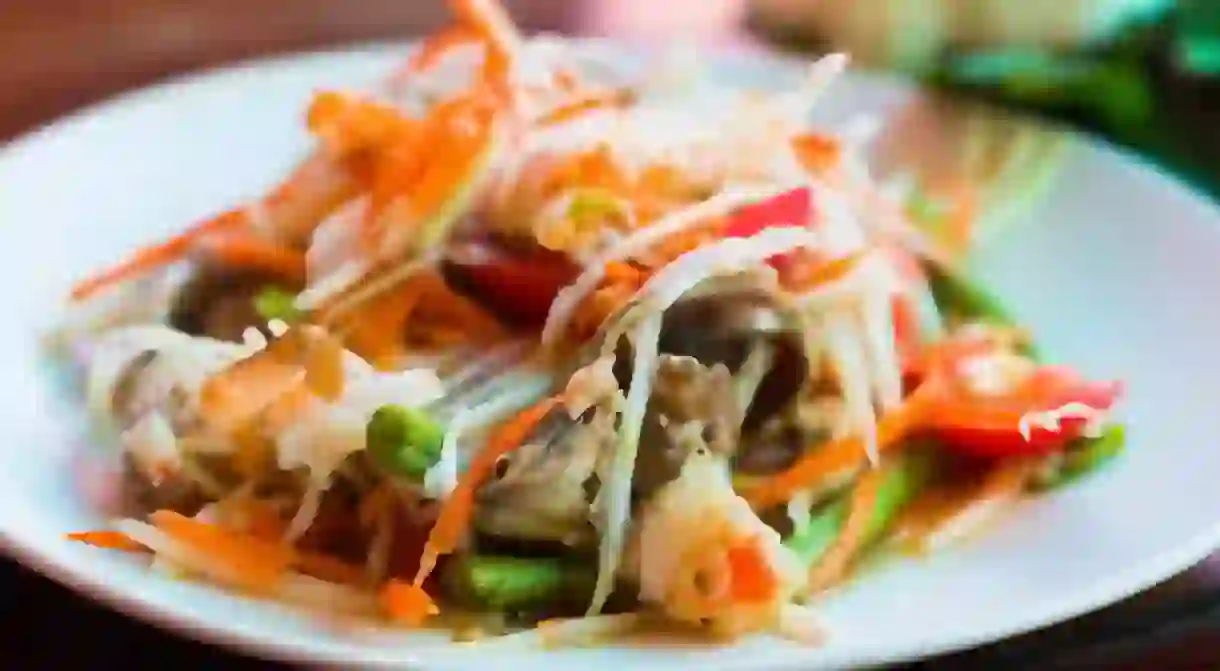A Brief History of Som Tum, Thailand’s Popular Green Papaya Salad

When people think of salads, some leafy, colorful dish usually comes to mind. Like all distinctive Thai cuisine, however, Thai salads are hardly the conventional greens a person is used to devouring. Instead, Thai salads are notable for their use of meat, especially seafood, as well as their unique blend of herbs and for possessing an extra kick from prick, meaning Thai chili. One of the most crowd-pleasing of them all is som tum, or green papaya salad. Here is a brief history of this savory dish.
What is it?
The reassuring clink of clay pestle to mortar can be heard in food markets across Thailand. Cooks and chefs use this kitchen device in the making of this delicious salad, which only takes but a few minutes to prepare. Thai chilies, fresh garlic, dried shrimp, fish sauce, sweet palm sugar to soften the blow of the Thai chilies, peanuts, juicy limes, cherry tomatoes, green long beans, and green papaya are all needed to make this signature Thai dish.

Process
The green papaya is cut open, and its seeds are removed; then it is thinly sliced to act as the main ingredient of the salad. Some vendors will add shredded carrots for color as well. The papaya should not be ripe, as this helps to give the salad its crunchy texture. The ingredients (except the green papaya, long beans, peanuts, and tomatoes) are tossed into the mortar in a precise order while the chef consistently moves and smashes them with the pestle until the ingredients turn into a liquid form, which will act as the salad dressing. The rest of the ingredients are then added and mixed before being served. Normally, vendors will add additional roasted peanuts on top for added texture and flavor. Thai food is well-known for being salty, sweet, spicy, sour, and bitter—all at the same time. Papaya salad is certainly one of these dishes that encompasses all of these flavors.

Garnishes and Seasoning
Be sure to be wary of the number of chilis added to this salad; more than one will leave many visitors’ mouths on fire. The dish is best eaten with kow neeyao, or sticky rice, and for those who enjoy seafood, a crab or two is oftentimes thrown in for added crunchiness and flavor. Each region seemingly has its own version of this dish, so visitors are surprised almost every time they devour green papaya salad.

History
Papaya salad is not only a signature dish in Thailand but also a popular one in Cambodia, Laos, and Vietnam, though the Thai version is certainly the most famous. Food historians believe the dish originated in Thailand’s northeast neighbor of Laos, which might be why green papaya salad is one of the most popular dishes in Isaan, the northeastern region of the country. As the largest region in Thailand, many of the most remarkable of dishes commenced their journey into the foodie scene from this rarely visited area.

Different names
The dish in Laos is known as tam maak hung, and though it is similar to Thailand’s version, there are a few things that differ. Instead of using fish sauce, for instance, Laos vendors add in a fermented fish paste, which is much more overpowering and oftentimes not well liked by visitors who have yet to acquire a Laos palate. Green eggplants are also added to papaya salad in Laos, and it is generally not as sweet as Thailand’s version, though they are equally as spicy. While some Thai restaurants offer papaya salad, it is popularly known as a street food.
Did you know – Culture Trip now does bookable, small-group trips? Pick from authentic, immersive Epic Trips, compact and action-packed Mini Trips and sparkling, expansive Sailing Trips.













